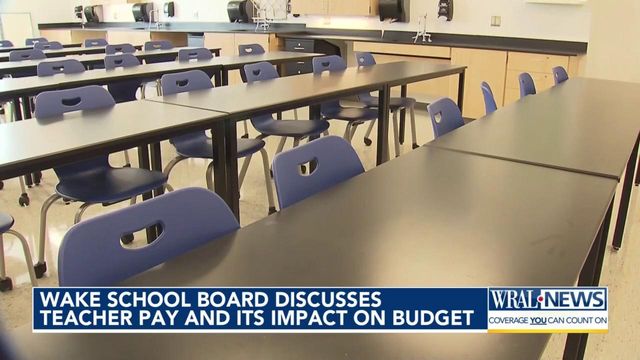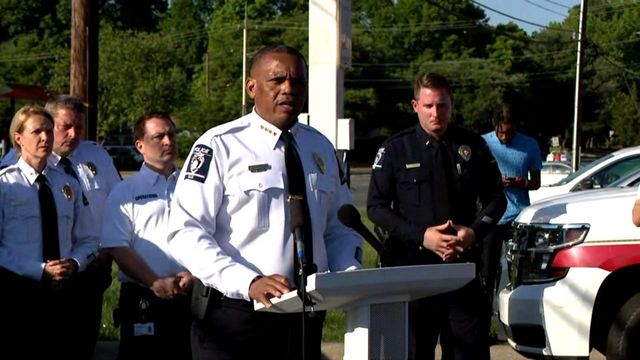Wake school board must figure out how to pay staff as federal funds dry up
The Wake County school system will propose a few alternative budgets for next year that include raises for employees — and the current school programming they could cut afford them.
Board members have posed but not necessarily agreed on various cuts to new programming funded using one-time federal pandemic relief dollars. That money will disappear next year, and the school board — like others around the country — is facing a decision on whether and how to keep what it funded.
That includes a $2.5 million before- and after-school supervision program for some students, $4 million for dozens of full-time school-level substitute teachers and $13.8 million for more than 100 behavioral health support professionals. Not all board members agreed to cut those things or on the extent to which to cut those things.
Meanwhile, the district is still struggling with staffing. It had 324 open bus driver positions in March — a 36.8% vacancy rate that has not stopped rising for years, even with periodic wage increases. Teacher vacancies in Wake County were about 2.1% in March — a slight improvement over the past two years, although the district has experienced high attrition in recent years — 16.7% from March 2022 to March 2023, according to the latest state attrition report.
“We need more than we’re asking for,” Board Member Lynn Edmonds said. She suggested cutting the new behavior support professionals, which include counselors, social workers and nurses, at schools that aren’t high needs.
“I’m nauseous to even suggest that,” she said.
The board discussed various ideas and feelings on how to move forward during a work session Tuesday afternoon. They’ll meet again during another afternoon work session on April 30, hoping to agree on a final budget proposal by the end of it. The board would then vote on May 7 on a proposal to send to county commissioners. In June, Commissioners will likely vote on how much local funding to provide for the school system.
The school system isn’t in a unique position. School systems across North Carolina and the nation are deciding what to do now that the billions of dollars in one-time federal assistance are drying up. Much of the funding went toward things such as one-time bonuses or one-time equipment purchases. But much of it also went to temporary employees and programs intended to boost learning and student support as test scores plummeted. Now, school systems believe at least some of those employees and programs have been beneficial and should stay.
“To be clear, this is not like any other year,” Board Vice Chairwoman Monika Johnson-Hostler said. Cuts will be challenging. “At the end of the day, there is nothing in this [budget] book that anyone wants to cut.”
Part of Superintendent Robert Taylor’s proposed budget for next year includes continuing funding for two sets of employees: Substitute teachers who work full-time at individual schools to help fill in and dozens of behavioral support professionals intended to help struggling students.
One of the temporary social workers spoke during the board’s public comment Tuesday night, arguing the struggles children and families are having since the Covid-19 pandemic haven’t fully dissipated.
Elizabeth Riley said she and other social workers work with thousands of children who don’t have a permanent home or who are foster children and need assistance in ensuring they can get to and from school.
Students who receive help are less likely to be chronically absent — a growing problem in schools and more likely to do better academically.
The most favored cut would be to a $2.5 million program that provides before- and after-school supervision for thousands of students whose buses drop them off very early to school or pick them up very late from school. It’s a solution to a problem already existing because of bus driver shortages that forced drivers to take on extra routes. Board members hope that using those funds toward raises may reduce the need for supervision by improving bus driver staffing levels.
Board Member Chris Heagarty suggested ending the full-time, school-level, substitute teacher program, which would save more than $2 million, even though he would hope to bring it back later.
"That's a tough choice," he said.
Board Member Cheryl Caulfield said she wants to keep the substitute teacher program because it's on-the-ground work. She wondered if any central office administrative positions, which are higher-paid, could be cut. She and others said more information on what those positions do would be helpful. Superintendent Robert Taylor cautioned that while central office staff don't work for one specific school, they're often assigned to a specific group of schools to support them with administrative tasks.
Taylor’s proposed budget didn’t include across-the-board raises, unlike budgets approved by the school board recently. But the school system provided cost estimates Tuesday for raising pay for hourly workers.
District officials say raising minimum pay by $0.24, from $17.26 per hour to $17.50 per hour, would cost $3.5 million. Raising the minimum pay to $17.75 would cost another $4.1 million. The cost would cover the minimum pay increase and a slight increase for all employees above minimum pay to keep wages different as employees gain years of experience. A raise of $0.24 per hour for each employee would provide another few hundred dollars per year, and each additional quarter per hour could provide another few hundred dollars.
Raising the minimum bus driver pay to $20 per hour — closer to the market rate, according to the district — would cost the district $1.1 million.
As an incentive to hire bus drivers, the district offers $260 per driver toward classing and permit tests. However, that perk for many school systems is wasted when people realize they can make more money elsewhere. About a quarter of all drivers who complete the training with the school system and earn their commercials river’s license never end driving for the school system.
Board members suggested the school system adopt a clawback policy to prevent people from using the training money but taking a job elsewhere.
Christina Spears, president of the Wake County chapter of the North Carolina Association of Educators, said raising pay is part of improving staffing and increasing the quality of schools.
“We want public schools to have what students need, which is fully staffed, fully funded, fully resourced schools,” Spears said. “Having that is how we recruit and retain not only staff but families and students here to make public schools the number one choice.”
The state plans to raise teacher pay by $1,000 or more per teacher next year, and Wake County always provides a local supplement on top of that.
According to Spears, the district can and should increase its supplement more than it’s currently set to do.
“We want Wake to remain competitive around what the local supplement is so we can recruit and retain educators, so we don’t lose them to other counties who may very well raise their supplement,” she said.
Teacher Kim Mackey told the board during public comment that her salary hasn’t kept up with inflation to tens of thousands of dollars over her career. She said it would at least help to know the school board and county still want to do what they can to support teachers.
“It’s hard finding hope in this budget,” she said.
As for teachers, Board Member Sam Hershey said the school system needs thousands more dollars per teacher to make a meaningful, systemic improvement in teacher recruitment and retention — something only the state can ultimately provide.
“There’s no amount we can cut and turn around and pay teachers… that will make up for what the state is not doing,” he said.
By law, the state is the primary funder of schools in North Carolina. Counties are charged with funding school buildings but often raise billions of dollars toward additional education services.
What’s in the budget
Taylor is recommending a $58.3 million budget increase from the county, but he’s divided his proposal into “must-do” items and “optional items.”
Taylor’s proposed budget increase of $58.3 million is higher than the county commissioners have approved in at least 17 years. The past two years, commissioners have approved their highest increases over that time, both about $50 million and about $6 million less than requested. If approved, the $58.3 million budget increase would bump the county’s contribution to the school system from $644.3 million to $702.6 million, or a 9.1% increase. Just 17 years ago, the county spent $300.7 million on district schools.
Within the $58.3 million proposal, the school system lists more than $32 million in “must-do” funding projects:
$9.9 million would go toward providing raises for locally funded employees that will match their salaries to state-funded employees, who are set to receive a raise from the General Assembly next year.
- $9 million would go toward charter schools in Wake County, which under state law are due a share of any local funding increase
- $4 million would go toward having a substitute teacher assigned to each school
- $3.8 million would go toward costs for the new elementary school opening next year in Holly Springs, Woods Creek Elementary
- $3.1 million would go toward paying teachers extra for having a Master’s degree — something the board agreed to do last year
- $2.3 million would go toward rising property costs, including $1.7 million in increased insurance premiums
The school system lists another $21.9 million in “optional” funding increases. That’s nearly all for maintaining certain employees whose positions have been funded by temporary federal dollars. That includes $13.8 million for more than 100 behavioral health support professionals, $3.6 million for more substitute teachers at each school and $2.5 million for supervision and snacks for students whose school buses are scheduled to be late.
WRAL reporter Shaun Gallagher contributed information to this report.











